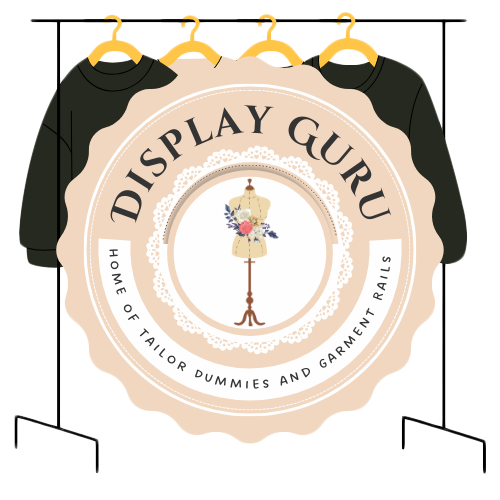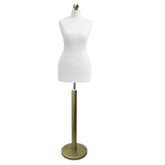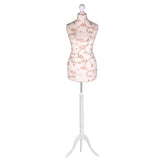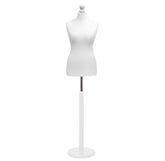Display Cabinets for Shops That Boost Sales
Choosing the right display cabinets for shops isn’t just about buying a piece of furniture; it's an investment that can genuinely shape your brand image and lift your sales. A great cabinet is a silent salesperson, drawing a customer's eye, protecting your valuable stock, and showcasing your products in their best light.
How to Choose the Right Display Cabinets
Picking out the perfect display cabinet goes far deeper than just what looks nice. It’s a strategic choice that can make or break how customers interact with your products. You need to think about the practical side of things—how a unit will fit into your space and, more importantly, how it will actively help you sell.
The demand for these fixtures is telling. The global display cabinets market was already valued at around £9.8 billion in 2023 and is expected to climb to an impressive £16.3 billion by 2032. This isn't just a trend; it shows how vital visual merchandising has become for creating stores that people genuinely want to spend time in.
Matching Cabinet Type to Your Products
First things first: what are you actually selling? The answer to that question will immediately narrow down your options.
-
Freestanding Tower Cabinets: These are your showstoppers. They're perfect for creating a focal point in your store. Think of them as the stage for your ‘hero’ products—that one-of-a-kind handbag, the latest piece of tech, or a rare collectible.
-
Wall-Mounted Cabinets: If floor space is at a premium, these are a lifesaver. They’re brilliant for grouping smaller, related items together, like a curated collection of perfumes or a range of artisanal gins.
-
Countertop Units: These little powerhouses are your secret weapon for encouraging impulse buys. Placing one by the till with jewellery, watches, or other small temptations is a classic tactic that really works.
The impact of well-placed displays on your bottom line is hard to ignore.
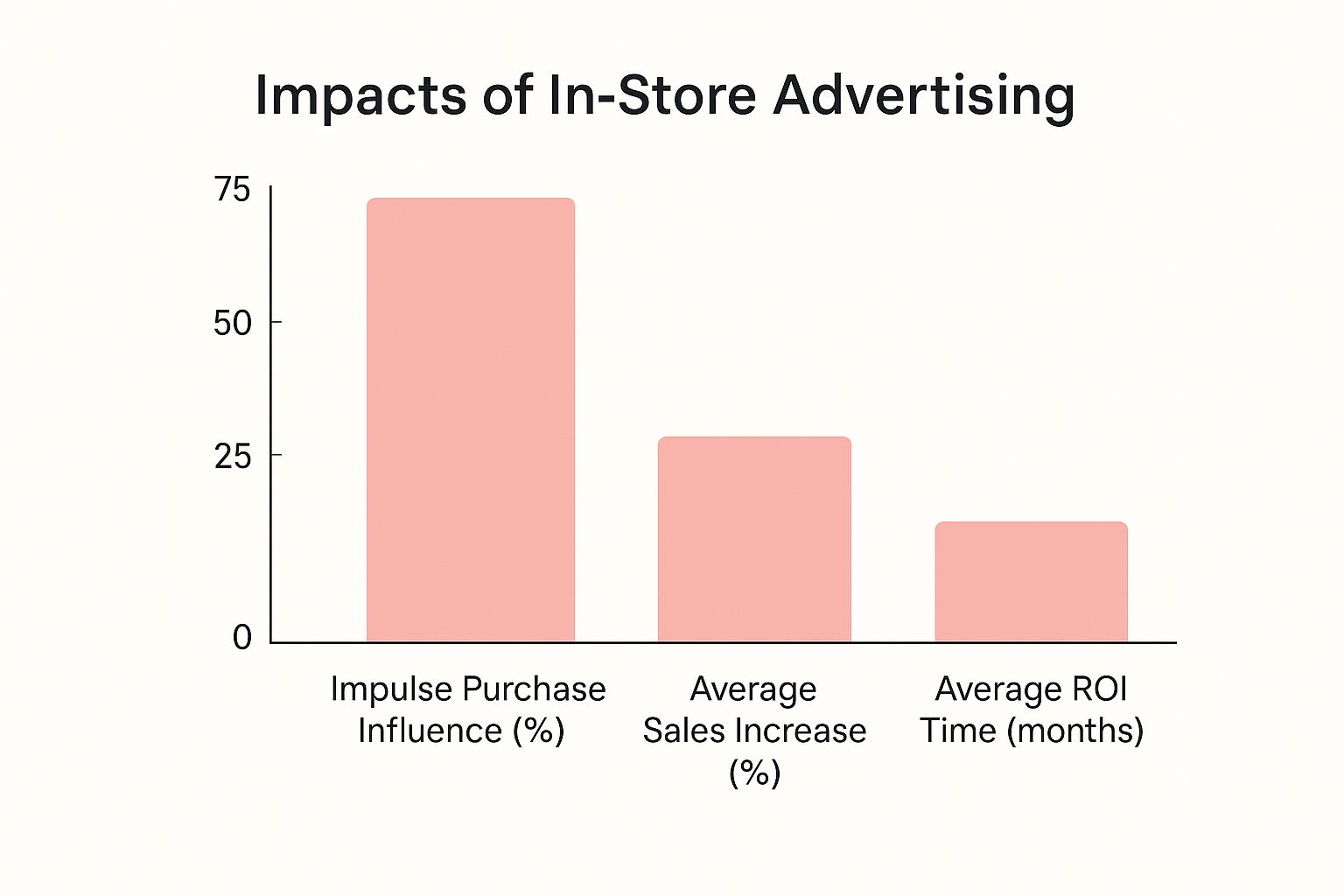
As you can see, there's a direct correlation between strategic displays and profitability. They have a massive influence on those last-minute impulse purchases and can deliver a surprisingly quick return on your investment.
To make the decision a bit easier, here’s a quick breakdown of which cabinet styles work best for different retail environments.
Matching Cabinet Types to Retail Needs
| Cabinet Type | Primary Material(s) | Ideal For | Key Benefit |
|---|---|---|---|
| Tower Display | Glass, Metal, Wood | High-value single items, electronics, jewellery | 360-degree visibility, creates a focal point |
| Wall-Mounted | Glass, Wood | Fragile collections, spirits, cosmetics | Saves floor space, protects delicate items |
| Countertop Unit | Acrylic, Glass | Watches, small gifts, impulse-buy items | Maximises point-of-sale opportunities |
| Revolving Cabinet | Glass, Metal | Small collectibles, eyewear, accessories | High-density storage with interactive appeal |
Ultimately, the goal is to find a unit that doesn't just hold your products but presents them in a way that feels natural for your specific brand and customer.
Material Matters: Creating the Right Atmosphere
The material you choose for your cabinet says a lot about your brand before a customer even looks at the price tag. Each one creates a completely different vibe.
-
Glass is all about maximum visibility and a clean, modern aesthetic. It’s the undisputed champion for luxury goods, where you want shoppers to see every last detail. If you're leaning this way, you might find some useful insights in this guide to the https://www.displayguru.co.uk/blogs/news/display-cabinet-with-glass.
-
Wood brings an immediate sense of warmth and traditional quality. Dark woods like mahogany can suggest heritage and craftsmanship, making them a fantastic fit for antique shops or high-end boutiques.
-
Metal offers a more industrial, contemporary look. It’s tough, durable, and looks right at home in modern retail spaces, especially for showcasing tech gadgets or designer streetwear.
Your display cabinet is an extension of your brand's story. The materials, lighting, and placement should all work in harmony to communicate quality and build desire before the customer even touches the product.
Of course, if you're in the food and beverage game, you'll need specialised units. For anyone needing chilled displays, you can explore our comprehensive guide on display fridge options to get the specific guidance you need. In the end, the right cabinet does more than just secure your stock—it elevates the feel of your entire shop.
Strategic Placement to Guide Customer Flow
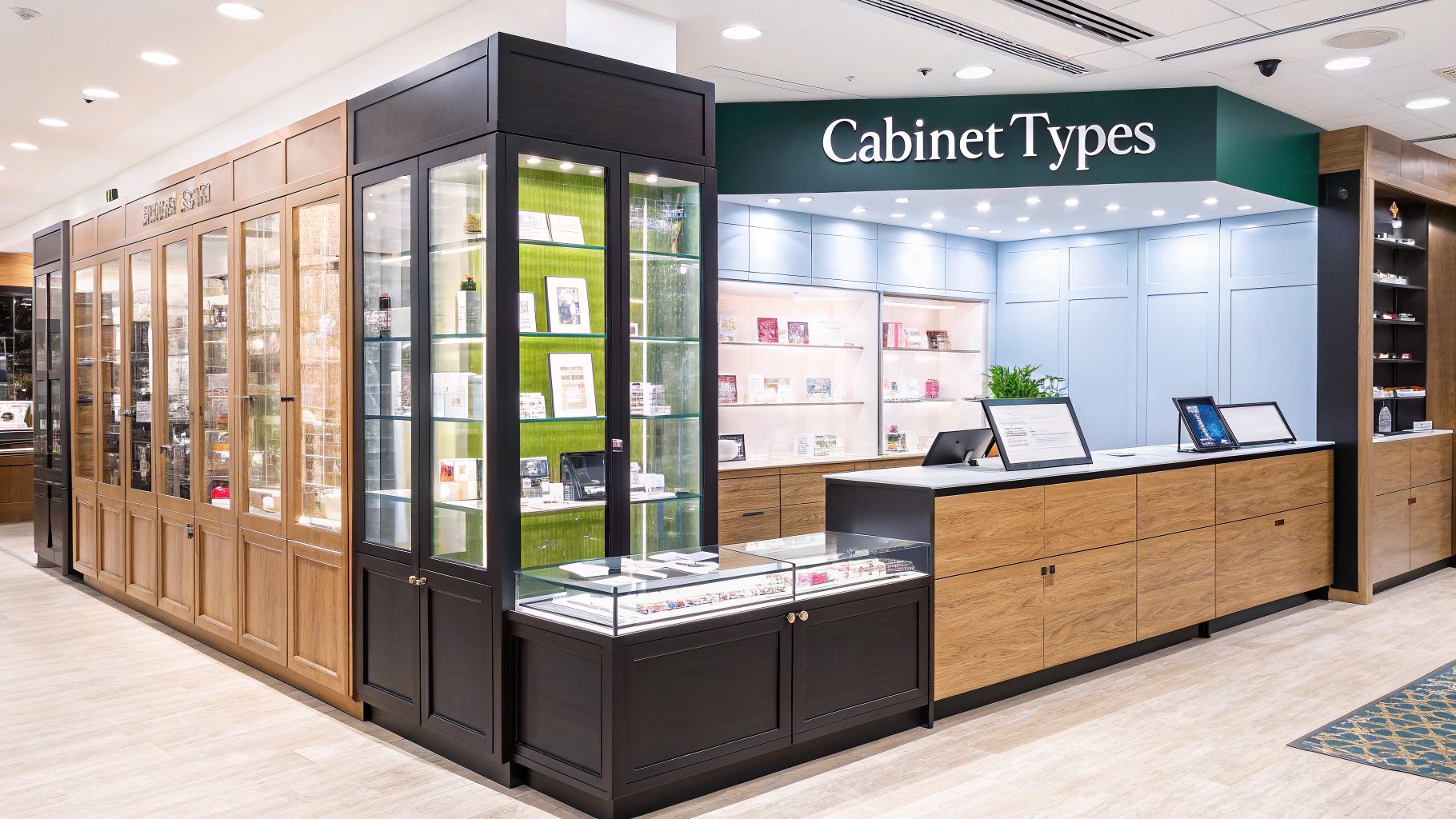
The location of your display cabinets for shops can influence your sales figures just as much as the products you put inside them. You need to think of your shop’s layout as a carefully crafted journey. Each cabinet is a landmark, a signpost guiding customers along a path you've designed to lead them deeper into your space.
One of the biggest mistakes I see is retailers pushing all their fixtures against the walls. It creates this sterile, uninviting 'runway' effect right down the middle and does nothing to engage shoppers. Instead, think about using freestanding display cabinets to create a more dynamic, intuitive flow. A single, well-placed tower cabinet can completely transform a long, open space, creating a natural point of interest that pulls people in.
This kind of thinking turns your floor plan from a passive container for products into an active sales tool. By arranging your layout with intention, you can steer foot traffic, get rid of frustrating bottlenecks, and place your high-margin items right where they'll be seen and bought.
Creating Focal Points and Power Walls
A classic and incredibly effective strategy is to establish a ‘power wall’. This is usually the first wall a customer sees when they walk through your door, and it needs to make an impact. This is where you put your most compelling products, housed in your most attractive display cabinets, to set the tone for the entire shopping experience.
Beyond the main power wall, you can use individual cabinets to create smaller focal points throughout the shop. Imagine a brilliantly lit cabinet at the end of an aisle. It acts like a destination, drawing customers past other product areas just to see what's on display. It’s a simple but powerful trick.
Here are a few pointers I've picked up over the years:
- Forge a Clear Path: Try to arrange your cabinets to create a circular route. Most shoppers naturally turn right when they enter a store, so designing a path that flows in that direction is often a safe bet.
- Introduce ‘Speed Bumps’: Don't be afraid to place smaller, eye-catching countertop display cabinets in the middle of wider aisles. These act as 'speed bumps', slowing customers down and encouraging them to stop and browse.
- Work Your Sightlines: Stand at your shop’s entrance. Where do your eyes naturally fall? Those are your premium spots, the perfect places to showcase key collections.
"A well-organised shop layout doesn't just look better—it feels better. By guiding customers effortlessly from one area to the next, you reduce decision fatigue and make the entire shopping experience more enjoyable and, ultimately, more profitable."
Applying Space Planning Principles
Getting this right means understanding the fundamentals of how to arrange any area for maximum impact. Taking a moment to read up on the principles of effective space planning will give you a solid foundation for optimising your display strategy. This isn't just about filling space; it's about making every square foot earn its keep. When you start thinking like a store planner, you can ensure every single cabinet is contributing to a seamless customer journey.
For a deeper dive into how placement fits into the bigger picture, our expert visual merchandising guidelines have you covered. Mastering these techniques is how you turn passive browsing into active discovery.
Arranging Products for Visual Impact
A well-arranged display cabinet is so much more than just a place to put products. It’s a silent salesperson, telling a story that makes customers stop, look, and engage. You're essentially moving from simple storage to curating a mini-experience that showcases your products' best features and sparks a real desire to buy.
The secret is to put on your visual merchandiser hat. You're not just tidying up stock; you're building a deliberate composition. Every single item needs a purpose and a place, all working together to create a look that feels balanced, interesting, and easy for a customer's eye to follow.
Creating a Clear Visual Hierarchy
The best displays instinctively guide the viewer's eye where you want it to go. One of the most tried-and-tested techniques for this is the pyramid principle. It's simple: arrange your products at different heights, placing the tallest or most important item right in the centre to create a natural focal point. A shopper's eye will be drawn to that peak and then naturally travel down the sides, taking in the entire collection.
Getting those varied heights is easier than you think:
- Use Acrylic Risers: These are fantastic for giving smaller items a lift without stealing the show. Their transparency means the product remains the hero.
- Stack Products: Where it makes sense for your merchandise, stacking things like gift boxes or books is a great way to build height organically.
- Incorporate Props: A stylish decorative box or a small pedestal can add elevation while also tying into the overall theme of your display.
This kind of structure stops a display from looking flat and boring. It adds a dynamic quality that can catch a customer's eye from clear across the shop floor.
Think of your display cabinet as a stage and your products as the actors. Use risers and props to give your star products the spotlight they deserve, so they don't just get lost in the crowd.
Applying the Rule of Three
Another powerful guideline from the world of design is the rule of three. For whatever reason, our brains find groupings of three more appealing and memorable than even-numbered sets. Using this in your display cabinets for shops helps create a sense of natural balance and avoids a look that feels too rigid or symmetrical.
So, instead of placing two or four items together, try arranging three. A great example would be a large vase flanked by two smaller, complementary ones. This odd-numbered group just feels more organic and less staged, encouraging the eye to dance between the objects.
This concept isn't just about the number of products, either. You can group items by theme, colour, or function to tell a more complete story. A jeweller, for instance, might display a necklace with its matching earrings and a bracelet. Not only does this look visually satisfying, but it also subtly encourages upselling by showing shoppers how beautifully the pieces work together as a full set.
For retailers selling clothes, similar principles apply when creating outfits, a topic we cover in more detail in our guide to display stands for clothing. When you group items this thoughtfully, you're creating a narrative that connects with people and makes your products far more desirable.
Lighting Your Displays to Capture Attention
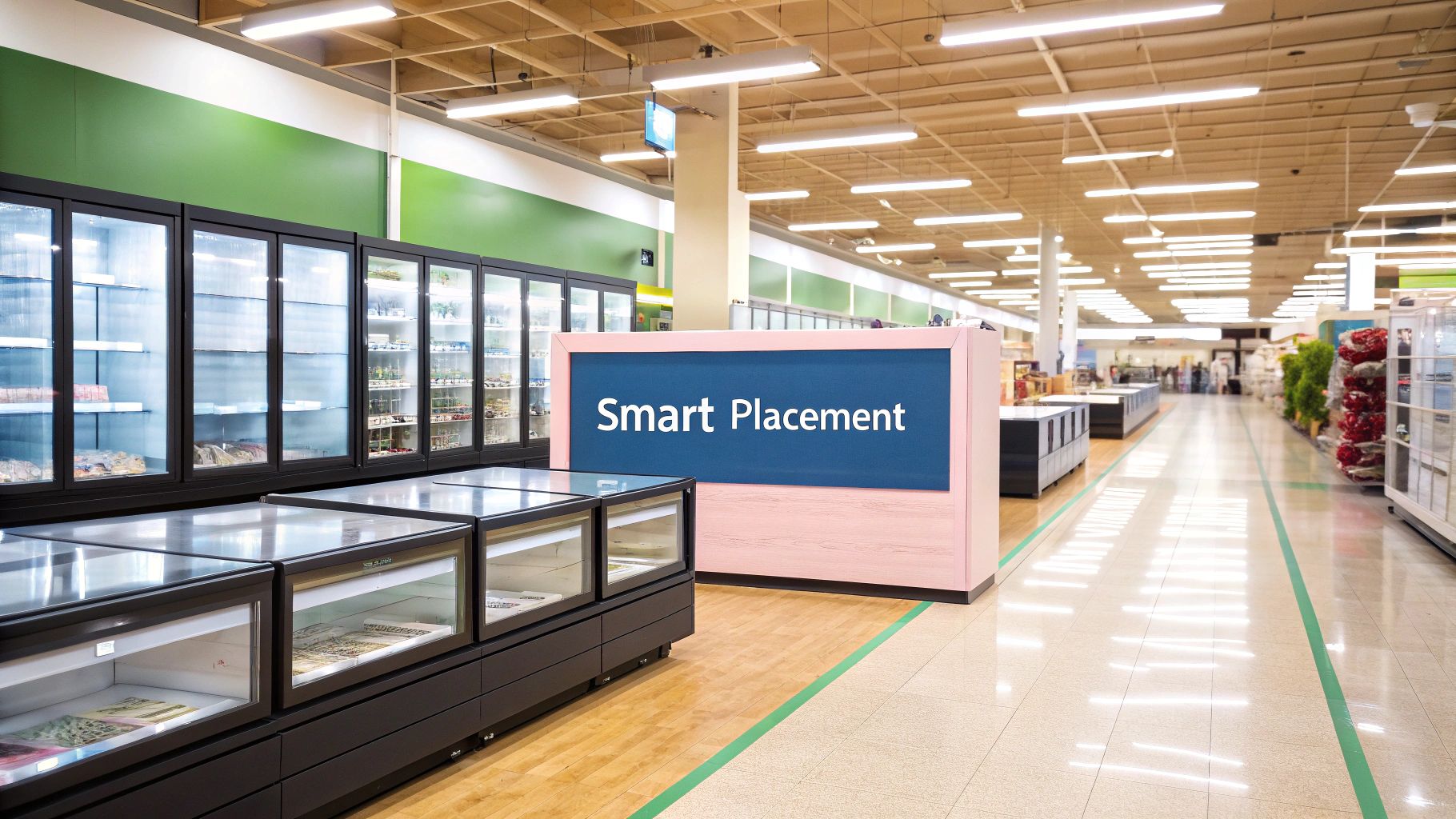
Think of lighting as the secret weapon that transforms your display cabinets for shops from simple storage into a genuine showcase. Proper illumination is about so much more than just visibility; it’s about creating an atmosphere, highlighting fine details, and directing a customer’s gaze exactly where you want it to go.
A dimly lit cabinet can make even the most exquisite products seem dull and unappealing. On the other hand, well-placed lighting introduces depth, a touch of drama, and immediately elevates the perceived value of your items. It's often the single factor that decides whether a product gets a passing glance or a much closer look.
Choosing the Right Lighting Technology
In today's retail environment, LEDs (Light Emitting Diodes) are really the only way to go. They're the clear winner because they’re incredibly efficient, last for ages, and produce very little heat—a crucial feature when you're displaying delicate items like chocolates, cosmetics, or fine textiles.
When it comes to putting LEDs into your cabinets, you have a few excellent options:
- LED Strips: These are fantastic for casting a consistent, even glow. I find they work best when run along the interior front edges of a cabinet, as this bathes every shelf in light and gets rid of any pesky shadows.
- Spotlights: If you want to create a bit of theatre, spotlights are your best friend. A small, targeted spotlight can make a diamond ring dazzle or draw attention to the intricate craftsmanship of a watch.
Getting a little technical for a moment is well worth it to ensure your products look their absolute best. Pay close attention to two key metrics: the Colour Rendering Index (CRI) and Colour Temperature (CCT).
A high CRI (90+) is non-negotiable. It guarantees that your products' colours look true to life, just as they would in natural daylight. For anyone in fashion, art, or cosmetics, where colour accuracy is everything, this is an absolute must.
Mastering Lighting Techniques
The real magic happens when you start layering your lighting. I always recommend starting with ambient light, perhaps from some well-placed LED strips, to establish a good base level of illumination. From there, you can bring in focused spotlights to create highlights and pinpoint your star products. This layering technique builds visual interest and stops the display from looking flat.
The colour temperature of the light, measured in Kelvins (K), is what sets the mood. A warm white light (around 2700K-3000K) gives off a cosy, inviting feeling that’s perfect for boutiques or artisanal shops. A cool white light (4000K-5000K), however, provides a clean, modern feel that suits electronics or contemporary jewellery.
For craftspeople or anyone working with intricate details, having the right task lighting is vital. While focused on a different craft, the principles in our article on choosing lamps for sewing offer some great insights that apply to any detail-oriented work. By getting these lighting elements right, you can turn your display cabinets into incredibly effective sales tools.
Specialised Cabinets for Food Retail
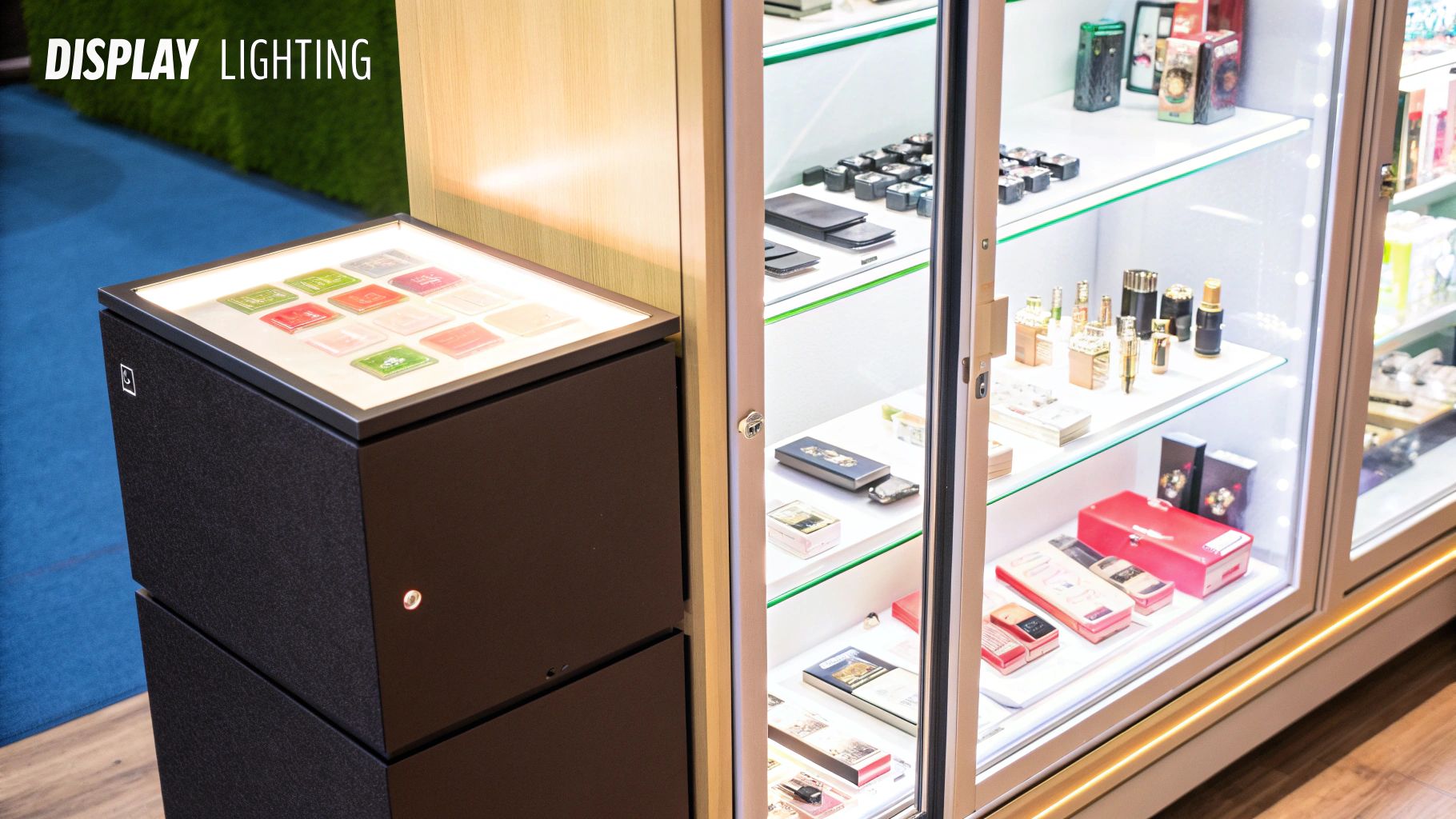
Displaying food is a completely different ball game compared to other types of retail. You're constantly juggling strict safety regulations with pure sensory appeal. Freshness is paramount, and presentation is everything. For any bakery, deli, or café, the right display cabinets for shops aren't just an asset; they're absolutely fundamental to success.
These units are far more than just furniture. Think of them as precision instruments, engineered to preserve the quality of your food while making every single item look completely irresistible. The choice you make has a direct line to food safety, product lifespan, and, of course, your sales figures.
It's a booming market for a reason. With consumer demand for fresh, ready-to-eat options on the rise, the food display cabinet market is expected to grow to an incredible USD 46.09 billion by 2032. This growth is all about the need for advanced units that masterfully combine perfect temperature control with stunning visuals.
Choosing Between Heated, Refrigerated, and Ambient
What's on your menu? The answer to that question will steer you towards the right type of cabinet. In reality, most food businesses need a combination of all three to operate properly. Getting this mix right is the key to maintaining quality and staying compliant.
-
Refrigerated Cabinets: An absolute must for anything dairy-based, like cheesecakes, as well as fresh sandwiches and salads. When you're browsing models, look for ones that promise consistent temperature distribution to avoid nasty "hot spots" that can spoil your stock.
-
Heated Cabinets: The perfect home for pies, pasties, and other hot snacks. A unit that includes humidity control is a real game-changer here, as it stops products from drying out and keeps them looking delicious for hours.
-
Ambient Cabinets: Ideal for goods that are best kept at room temperature, such as fresh bread, croissants, and certain types of cake. These cabinets are fantastic for keeping products safe from pests and airborne dust while ensuring they're still in full view.
The real art lies in merging functionality with aesthetics. Your cabinet has to meet tough hygiene standards—think easy-to-clean surfaces like stainless steel and glass—while also framing your food in the most flattering way possible.
Strategic Placement for Maximum Sales
Where you put your cabinets can make a huge difference to what your customers buy. A classic, proven strategy is to place a refrigerated unit filled with colourful cakes and desserts right next to the till. It’s the perfect way to tempt people into an impulse buy while they're waiting to pay.
Along the same lines, why not position a heated cabinet near the entrance? The aroma of warm pastries wafting through the door is a powerful welcome. And always remember to place your daily specials right at eye level to grab immediate attention.
When you think about placement this way, your display setup transforms into a silent, powerful sales tool. It can encourage cross-sales, highlight your most profitable items, and guide your customers' choices. For more ideas on optimising your layout, check out our in-depth guide on the essential display cabinet for shops at https://www.displayguru.co.uk/blogs/news/display-cabinet-for-shops.
Keeping Your Cabinets in Top Shape for Long-Term Value
Your display cabinets are a serious investment. They're not just furniture; they're the silent salespeople on your shop floor, framing your products and shaping customer perceptions. To protect that investment and ensure they look fantastic for years to come, a little proactive care goes a long way.
Think of it this way: regular maintenance isn't just about cleaning. It's about preserving the professional image of your brand. A spotless, well-functioning cabinet tells customers you care about quality and detail, which instantly builds trust.
Tailor Your Cleaning to the Material
You wouldn't wash a silk shirt the same way you wash a pair of jeans, and the same logic applies to your cabinets. Using the wrong cleaning products can cause lasting damage, so it's crucial to know what you're working with.
-
For Glass and Acrylic: The enemy here is streaks. Grab a good microfibre cloth and a proper glass cleaner. A fantastic DIY alternative is a simple 50/50 mix of white vinegar and water—it cuts through grime without the harsh chemicals that can degrade seals over time.
-
For Wood Finishes: A regular dusting with a soft, dry cloth is your first line of defence. When it needs a bit more, use a mild, wood-friendly soap mixed with a little water. Apply it with a cloth that’s just damp, not soaking, and be sure to dry the surface immediately afterwards. A key tip: steer clear of any polishes containing silicone, as they create a sticky build-up that actually attracts more dust.
-
For Metal Frames: Stainless steel and chrome are usually quite forgiving. Most of the time, a quick wipe with a damp cloth is all you need. To tackle fingerprints, a dedicated stainless steel cleaner is best. Always remember to wipe in the direction of the grain—this simple trick prevents tiny scratches and keeps the metal looking its best.
It's More Than Just a Surface-Level Job
A truly well-maintained cabinet is more than just clean; it’s fully functional and safe. A quick weekly once-over of its moving parts can save you a lot of headaches down the line.
A pristine display cabinet does more than showcase products; it communicates care, quality, and professionalism. Regular checks on lighting, locks, and shelving integrity are as important as keeping the glass clean. This preserves the cabinet’s function and protects your valuable stock.
Keep an eye out for flickering or dead LED strips. Inconsistent lighting can make even the most premium products look cheap. Give all the locks a quick test to make sure they're secure, especially if they’re protecting your high-value items. Finally, give the shelves a gentle push to check for any wobbling—a loose bracket is an accident waiting to happen. A few minutes on these checks each week ensures your cabinets remain the valuable assets they are.
Answering Your Display Cabinet Questions
When you're investing in display cabinets for your shop, you're bound to have a few questions. It’s a significant purchase, and getting the details right—from security to presentation—is what makes it pay off. Let's walk through some of the most common queries we hear from UK retailers.
How Often Should I Change My Displays?
This is a classic question, and the honest answer is: it depends. There’s no hard and fast rule, as the ideal frequency is tied directly to your industry and how quickly your stock turns over.
If you're in a fast-moving sector like fashion or electronics, keeping things fresh is crucial. I’d recommend a refresh every 2-4 weeks to highlight new arrivals, follow seasonal trends, or just keep regulars intrigued. For shops with a more consistent inventory, like antique dealers or high-end watch sellers, you can stretch that out. A thoughtful rearrangement every 6-8 weeks is usually enough to stop the display from feeling stale and to draw attention to different pieces.
How Can I Secure and Showcase High-Value Items?
Security is, understandably, a top concern when putting expensive goods behind glass. Your first line of defence is always the glass itself. Don't compromise here; insist on toughened or laminated safety glass. It’s far more resistant to impact than standard glass. Then, pair it with a solid lock. High-quality plunger locks are a reliable standard, but modern electronic systems can offer even better peace of mind.
For an extra layer of protection, you could also consider:
- Alarm Sensors: These can be discreetly fitted to detect vibrations from forced entry or glass breakage, sending an immediate alert.
- Smart Placement: Position the cabinet where it’s always in a clear line of sight for your staff and well-covered by your CCTV cameras. Visibility is a powerful deterrent.
What's the Best Lighting for Jewellery?
Getting the lighting right can make the difference between a piece that sits and a piece that sells. For jewellery, the gold standard is cool-white LED lighting with a high Colour Rendering Index (a CRI of 90+ is what you're looking for).
This specific type of light is fantastic because it reveals the true, brilliant colours of gemstones and metals without casting a yellow or blue hue. To get that signature sparkle on diamonds and other faceted stones, use focused spotlights. The directed beams create flashes of light that are simply irresistible.
Pro Tip: One of the biggest advantages of LEDs is that they produce almost no heat. This means you can keep your most delicate pieces beautifully illuminated all day without worrying about heat damage over time.
Ready to transform your retail space with expertly designed displays? Explore the professional-grade mannequins, garment rails, and merchandising solutions at Display Guru. Visit our website at https://www.displayguru.co.uk to find the perfect tools to make your products shine.
